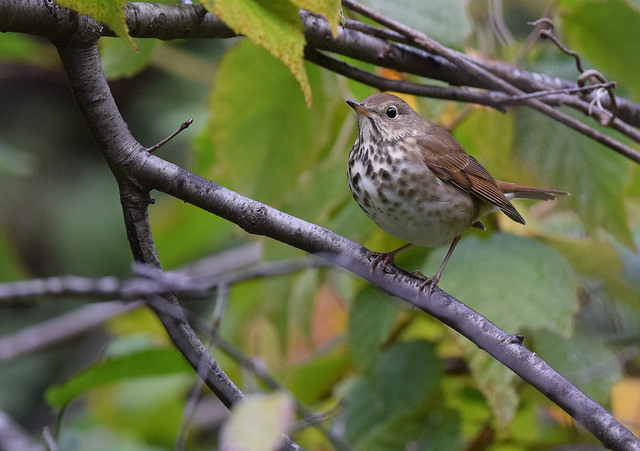 You know those sounds that slip across the senses until they settle, in the brain, on an association entirely unrelated to their maker? Those sounds that seem to almost synesthetically transform one thing into another? The way noise can be brilliant, or color evokes flavor, or a smell touches old dreams?
You know those sounds that slip across the senses until they settle, in the brain, on an association entirely unrelated to their maker? Those sounds that seem to almost synesthetically transform one thing into another? The way noise can be brilliant, or color evokes flavor, or a smell touches old dreams?
An unspectacular-looking, fist-sized bird called a hermit thrush makes a sound like that, when it sings. Its call is a variable set of layered chimings – like what water would be, if made into a bird, if you asked it to sing with a narrow feather-muffled throat instead of its own mud-and-cobble one.
Listen to this call for a moment, here. Consider that it has been transcribed as a sort of prayer: “Oh, holy holy, ah, purity purity eeh, sweetly sweetly.” I first remember hearing it in a sun-slanted aspen forest in Colorado, on my way up to a 13,000-foot pass and a hotspring on the other side. It seemed to descend through the glowing boles at the same stepped angle as the light. To come from all directions. To touch the surrounding talus fields and cliffs with little hands. It so filled me with listening silence that for years since, I have thought of tattooing a sound spectrogram of that song on my skin, to remind me of the places where I feel most at home in it.
Now listen to the song slowed, here: You will begin to notice the split in the hermit thrush’s voice, two notes carried by the dual voicebox that birds share, called a syrinx. Drawn out, his call becomes something that feels deeply Cretaceous, a dinosaur warbling through the jungle. Calling threat to his rivals, calling out his territory, calling plaintively for love.
A bird’s voice does all of that. It can also reveal other things: Where he is from, whether he is well or sick, whether he has been exposed to pollutants like PCBs and Bisphenol-A. And hermit thrush voices, it turns out, may also contain stories about the ancient movements of landscape and climate, and how these shape lives.
A pair of researchers from Dalhousie University in Nova Scotia, Canada recently analyzed the songs of 100 different individuals, from recordings taken across the bird’s North American range and spanning the years between 1951 and 2015. Their analysis, published last month in The Auk: Ornithological Advances, reveals distinct differences based on geography. A hermit thrush song, for their purposes, is divided into two chunks: A sustained opening note, and all the pretty stuff that follows. Subspecies in the northeastern U.S. and across Canada sang with a much wider range of frequencies in the opening note of their songs, while subspecies in the West began their songs with a longer sustained note than their eastern cousins. Meanwhile hermit thrushes of the mountain west sang their opening notes at much lower frequencies than those who stuck to West Coast lowlands.
Authors Sean Roach and Leslie Phillmore trace the division between west and east back a million years, to a time when massive Pleistocene glaciers likely sliced the species into two genetically distinct lineages with demonstrably different bodies, and sent their voices jagging in different directions, too, producing the variation we hear today. The division between western birds also may come at least partly from a glaciation 700,000 years ago, later reinforced by differences in migration habits that kept the birds separate—with coastal birds traveling north-south, and mountain birds migrating between high elevations and nearby valleys–amplifying their idiosynchracies.
Those kinds of changes don’t necessarily happen slow. Birdsongs are picking up the stories of their places right under our noses. Species in urban areas who must sing over the roar of human bustle diverge from their rural and remote cousins. Anthropogenic climate change reshapes migrations, dropping some species in novel places, with novel neighbors and as yet untold consequences for the way they sing.
Close your eyes and listen again to that slowed hermit thrush song. Do you hear the grind of ancient ice in the descending notes? What stories about our time will they someday tell? I have no answer, but I hope they remain forever a prayer to the endurance of beauty in even a wildly offkilter world: “Oh, holy holy, ah, purity purity eeh, sweetly sweetly.”
Image of hermit thrush courtesy of Flickr users Andy Reago & Chrissy McClarren.
Thank you.
A beautiful and haunting song. I don’t think I’ve heard it in person, but I’ll be sure to listen for it on future bird walks.
I love this piece. I am not surprised at it though. I know every creature has its language, but I do enjoy our efforts to figure it all out, as long as the aren’t intrusive.
My naturalist friend Steve Jones says that the Hermit Thrush (mountain west) sings an echo of its own beautiful song on a different pitch, and that it is then repeated agin by nearby mountainsides. I like your mnemonic as well. So humans, like many animals, can express a similar thought in many different ways!